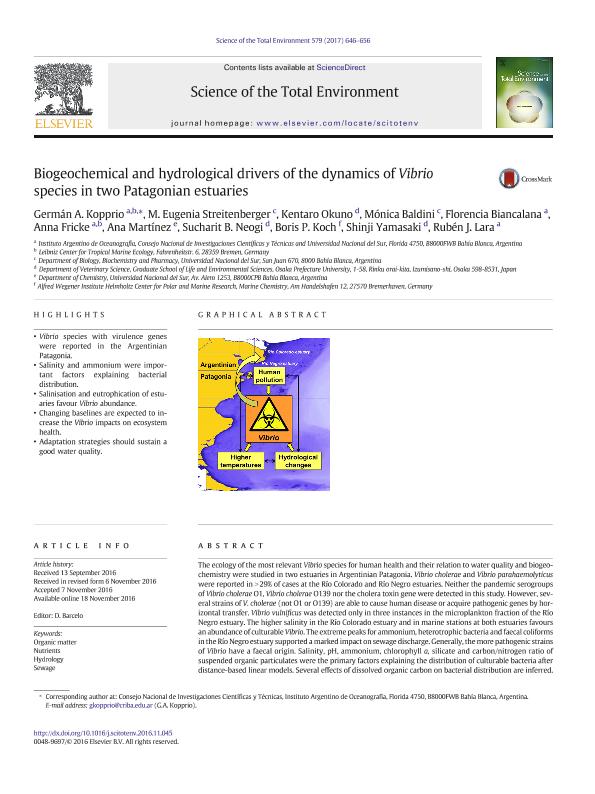Artículo
Biogeochemical and hydrological drivers of the dynamics of Vibrio species in two Patagonian estuaries
Kopprio, Germán Adolfo ; Streitenberger, Maria Eugenia; Okuno, Kentaro; Baldini, Monica Diana; Biancalana, Florencia
; Streitenberger, Maria Eugenia; Okuno, Kentaro; Baldini, Monica Diana; Biancalana, Florencia ; Fricke, Anna Lena
; Fricke, Anna Lena ; Martínez, Ana María
; Martínez, Ana María ; Neogi, Sucharit Basu; Koch, Boris Peter; Yamasaki, Shinji; Lara, Ruben Jose
; Neogi, Sucharit Basu; Koch, Boris Peter; Yamasaki, Shinji; Lara, Ruben Jose
 ; Streitenberger, Maria Eugenia; Okuno, Kentaro; Baldini, Monica Diana; Biancalana, Florencia
; Streitenberger, Maria Eugenia; Okuno, Kentaro; Baldini, Monica Diana; Biancalana, Florencia ; Fricke, Anna Lena
; Fricke, Anna Lena ; Martínez, Ana María
; Martínez, Ana María ; Neogi, Sucharit Basu; Koch, Boris Peter; Yamasaki, Shinji; Lara, Ruben Jose
; Neogi, Sucharit Basu; Koch, Boris Peter; Yamasaki, Shinji; Lara, Ruben Jose
Fecha de publicación:
02/2017
Editorial:
Elsevier Science
Revista:
Science of the Total Environment
ISSN:
0048-9697
Idioma:
Inglés
Tipo de recurso:
Artículo publicado
Clasificación temática:
Resumen
The ecology of the most relevant Vibrio species for human health and their relation to water quality and biogeochemistrywere studied in two estuaries in Argentinian Patagonia. Vibrio cholerae and Vibrio parahaemolyticuswere reported in N29% of cases at the Río Colorado and Río Negro estuaries. Neither the pandemic serogroupsof Vibrio cholerae O1, Vibrio cholerae O139 nor the cholera toxin gene were detected in this study. However, severalstrains of V. cholerae (not O1 or O139) are able to cause human disease or acquire pathogenic genes by horizontaltransfer. Vibrio vulnificus was detected only in three instances in the microplankton fraction of the RíoNegro estuary. The higher salinity in the Río Colorado estuary and in marine stations at both estuaries favoursan abundance of culturable Vibrio. The extreme peaks for ammonium, heterotrophic bacteria and faecal coliformsin the Río Negro estuary supported a marked impact on sewage discharge. Generally, the more pathogenic strainsof Vibrio have a faecal origin. Salinity, pH, ammonium, chlorophyll a, silicate and carbon/nitrogen ratio ofsuspended organic particulates were the primary factors explaining the distribution of culturable bacteria afterdistance-based linear models. Several effects of dissolved organic carbon on bacterial distribution are inferred.
Palabras clave:
Organic
,
Matter
,
Nutrients
,
Hydrology
,
Cholera
,
Sewage
,
Nutrients
Archivos asociados
Licencia
Identificadores
Colecciones
Articulos(IADO)
Articulos de INST.ARG.DE OCEANOGRAFIA (I)
Articulos de INST.ARG.DE OCEANOGRAFIA (I)
Citación
Kopprio, Germán Adolfo; Streitenberger, Maria Eugenia; Okuno, Kentaro; Baldini, Monica Diana; Biancalana, Florencia; et al.; Biogeochemical and hydrological drivers of the dynamics of Vibrio species in two Patagonian estuaries; Elsevier Science; Science of the Total Environment; 579; 2-2017; 646-656
Compartir
Altmétricas



